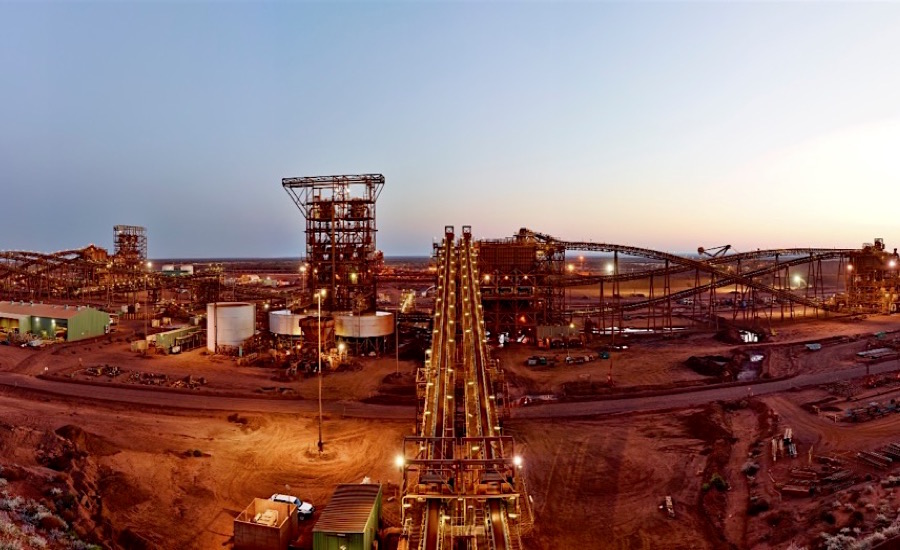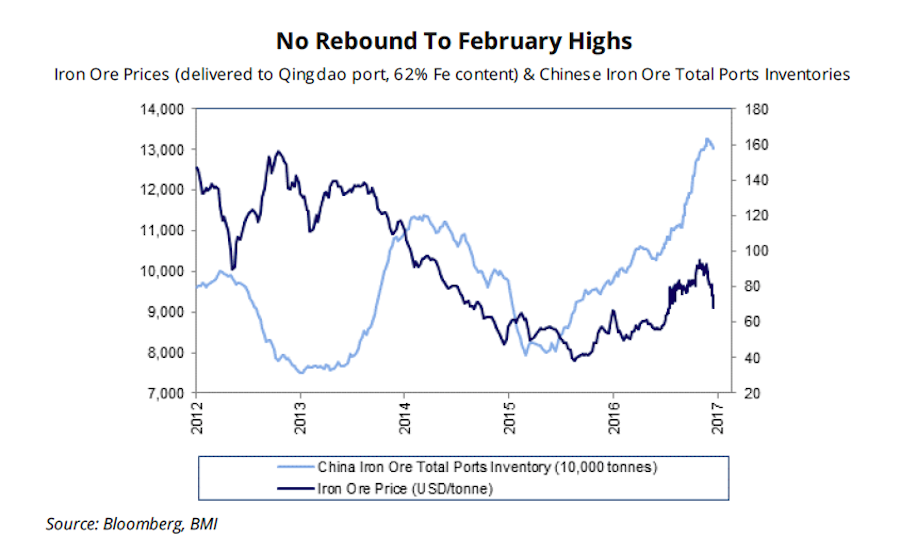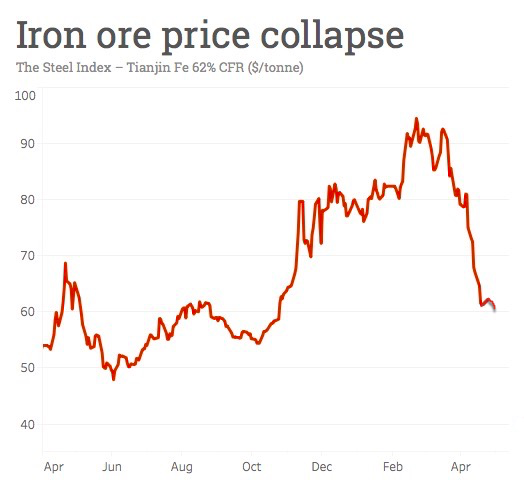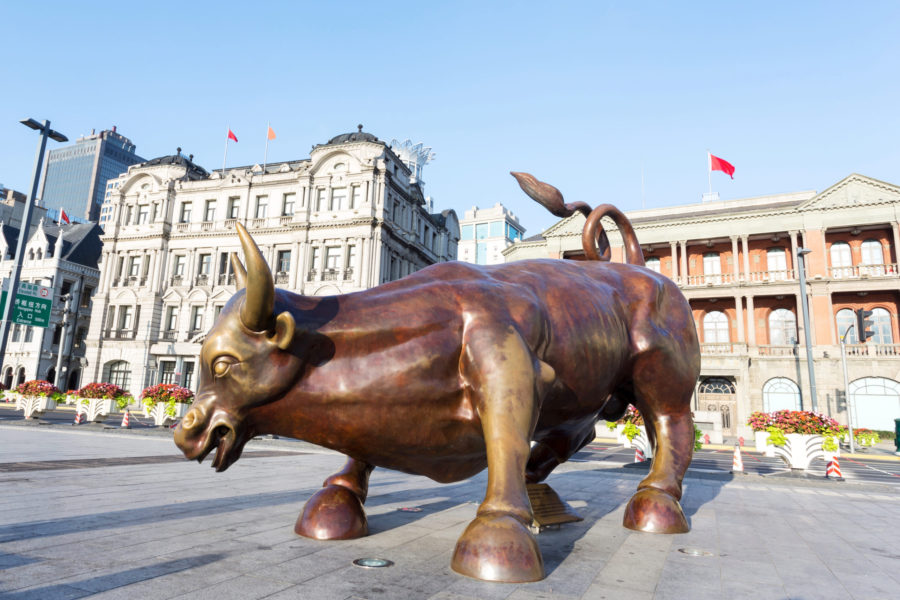Iron ore to slide below $46 a tonne by 2021 — analysts

The rally in iron ore prices that saw the commodity climbing near $100 a tonne earlier this year will likely be the highest mark seaborne will reach for at least the next five years, a new report published Tuesday shows.
According to BMI Research, prices will continue to slide for at least the next half decade, averaging lower each year through to 2021. The forecasters expect the commodity to drop to $70 a tonne this year, $55 in 2018, and decline to $46 by 2021, on rising supplies from Australia and Brazil and expectations for a surplus.
BMI Research expects the commodity to drop to $70 a tonne this year, $55 in 2018, and decline to $46 by 2021.
Major producers, backed by low costs, will continue to boost output and so drag prices down, the research arm of Fitch Group said in the report.
After peaking in mid-February, the steelmaking raw material fell into a bear market earlier this month as steel prices dropped and warnings about oversupply reappeared on the back fresh output coming from recently opened mines, such as Roy Hill in Australia, as well as Anglo American’s Minas Rio and Vale’s S11D in Brazil.
Last year, ore with 62% content in the port of Qingdao climber over 80%, extending the rally into 2017 to hit $94.86 in February, the highest price since 2014, according to the Metal Bulletin. It then began a painful and abrupt downward trend, falling 12% last month and continuing to drop in April. On Tuesday, the commodity lost another 46 cents to trade $66.07 a tonne.

The knock-on effect on the market value of the world’s top iron ore miners has not been minor, with world number four, Australia’s Fortescue Metals Group (ASX:FMG), a pure play iron ore producer, hardest hit. FMG stock has about 15% of its value over the last month and the Perth-based firm is now worth US$16.53 billion on the ASX following a 2.6% drop in Tuesday trading.
World number one Vale (NYSE:VALE) is down almost 6% over the same period, while diversified giants Rio Tinto (ASX, LON:RIO) and BHP Billiton (ASX:BHP) have also seen their value shrink since mid-March.
Several forecasters and banks had long warned the rally was not sustainable.
Several forecasters and banks had long warned the rally was not sustainable. Last week, Macquarie added to the gloomy sentiment by predicting that iron ore would continue to decline until finding support at around $50 a tonne, implying that falls of a further 20% were in store.
But not everyone is that pessimistic. For some, such as Stan Wholley, president for the Americas at CSA Global, the current downtrend is nothing but an expected correction. “I think people got exuberant about iron ore on the way up and we are seeing a bit of reality check right now,” he recently told MINING.com.
“There is not a great deal that can be done about the new supply — it will happen. However, there are indications that stockpiles in China are decreasing (albeit from record highs) which may slow or even halt the decline,” he noted.

While the analyst sees the commodity trading between $50 and $70 a tonne in the short term, he says fundamentals remain sound.
“There will be a focus on higher quality ores over the next few years as new supply comes in, but that is how it should be, and this will mean producers with lower quality ores will feel the pinch as buyers seek a discount,” Wholley warns.
{{ commodity.name }}
{{ post.title }}
{{ post.date }}




5 Comments
Paulo Tarso de Lima
My educated view:
2017: 68usd
2018: 73usd
2019: 82usd
2020: 81usd
2021: 80usd
Jonathan Hall
Total Rubbish – Has anyone looked at Minas Gerais- production of iron ore was 4.5m tons up 30% yes but thats 1m tons – oversupply nonsense. The only additional production from the majors this year is 25m tons from Vale SDI and 14 from Roy Hill. There is no additional supply coming from anywhere else. Do you know what the current world 5% increase in steel demand means more than an additional 100m tons of additional ore required, the Chinese are closing all their arc furnaces which use scrap steel – that means the steel output will have to be replaced by iron ore sourced steel 60m tons substitution, and the Chinese have just closed 29mills using low grade iron ore because of pollution so no more low grade output which caused the recent glut. Samarco will not recommence.
SHORTAGE NOT OVERSUPPLY – complete nonsense.
NorthAfricanMiner
Again, for the majority they have no clue….
Martin Raml
I would be rather cautious to assume that there is oversupply for the next years. Yes, if you put the actual nominal production and the the planned projects, then there may be a surplus. BUT things happen. grades go down, higher costs operations are shut down (Vale may substitute some of the higher cost operations by S11D), storms happen (look at the Australian coal production), environmental licencing gets harder etc. etc.
And I also don’t think the remaining players will enter a next battle for market shares. They are all too happy with the 60 USD – 80 USD range. This gives them good margins and holds potential new players away.
Elchagie Youssef Elchagie
Complete no sense study ,how to forecast three year price in advance and you don’t how is the economy will do and the supply for iron ore ,please enough